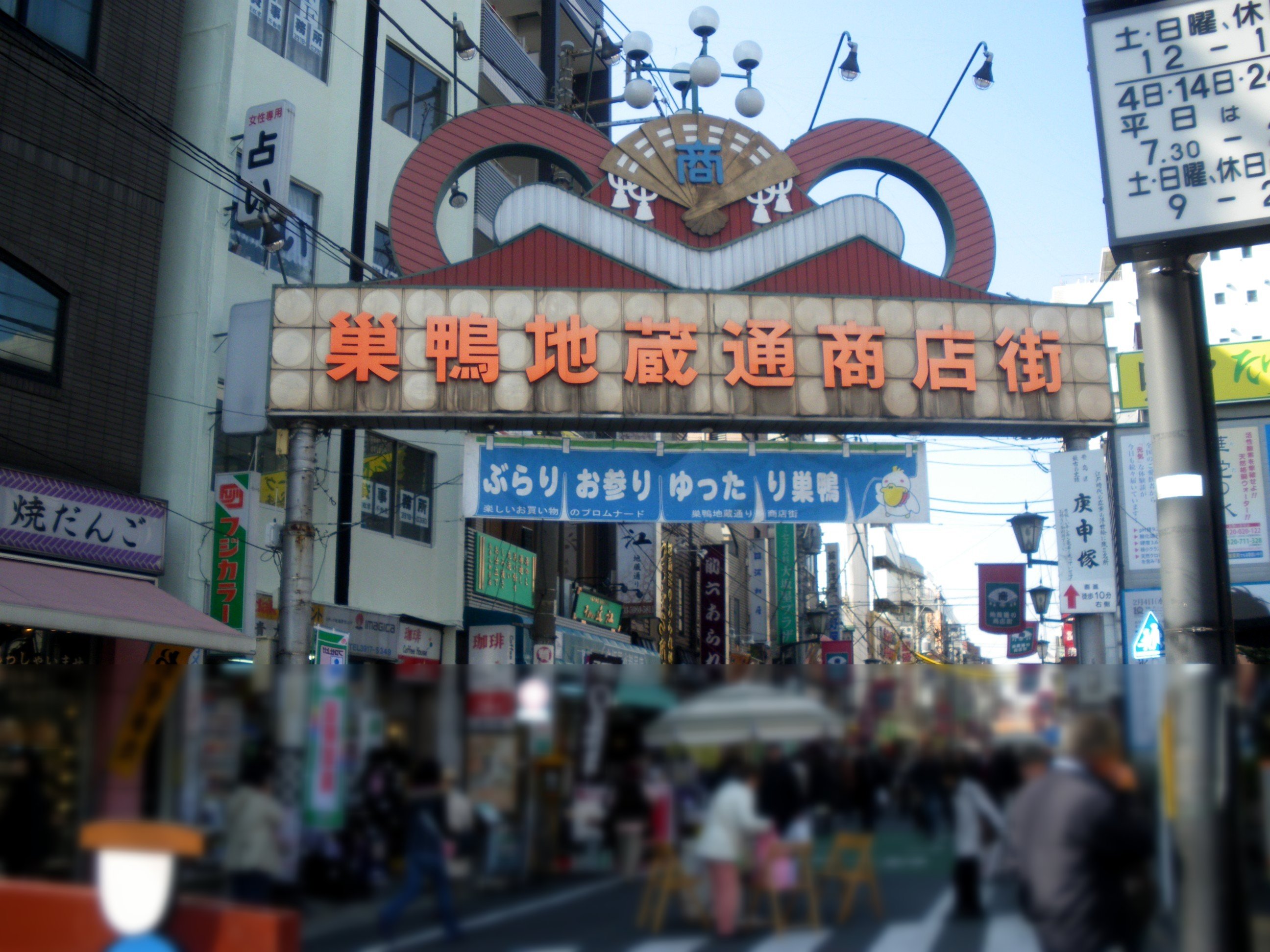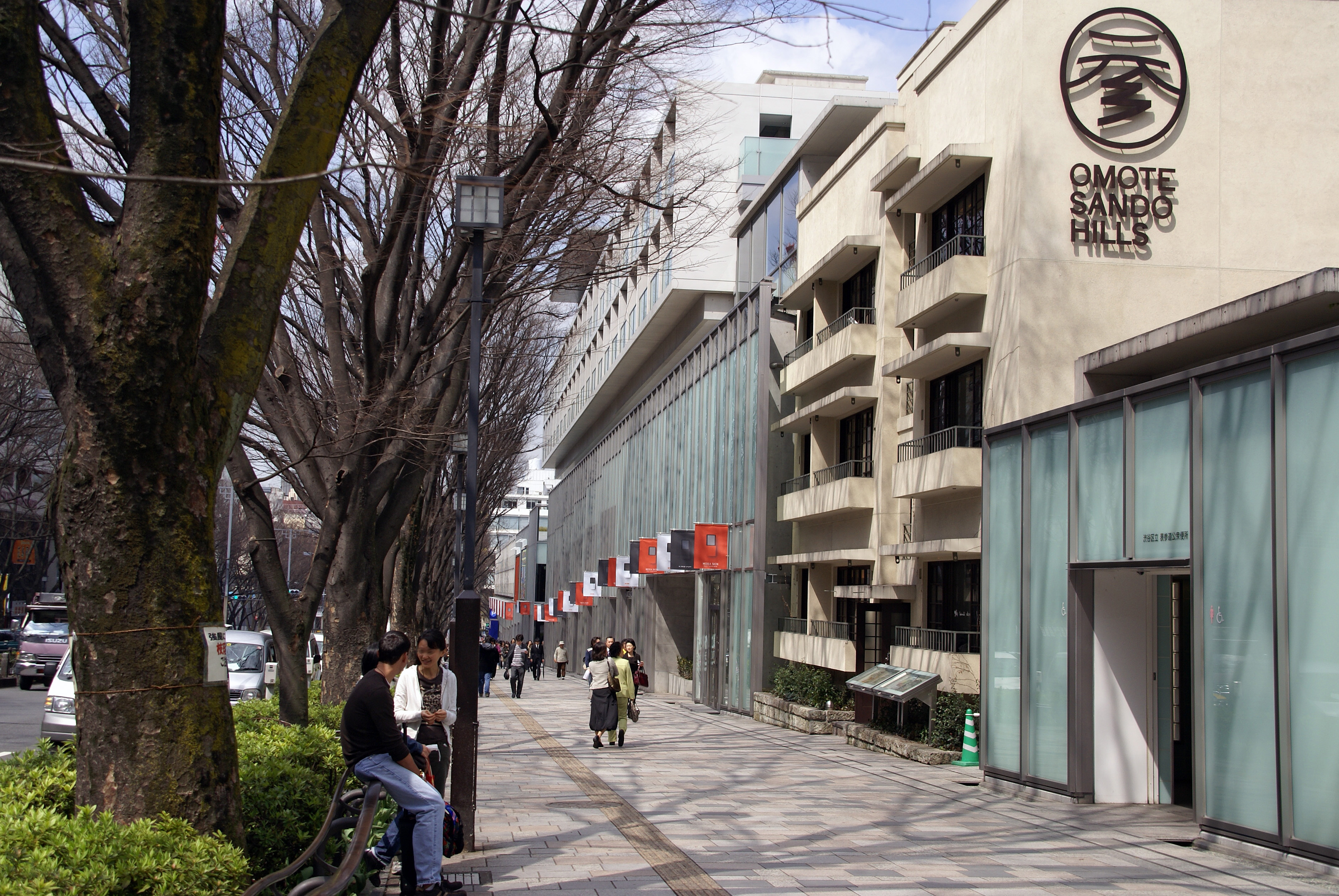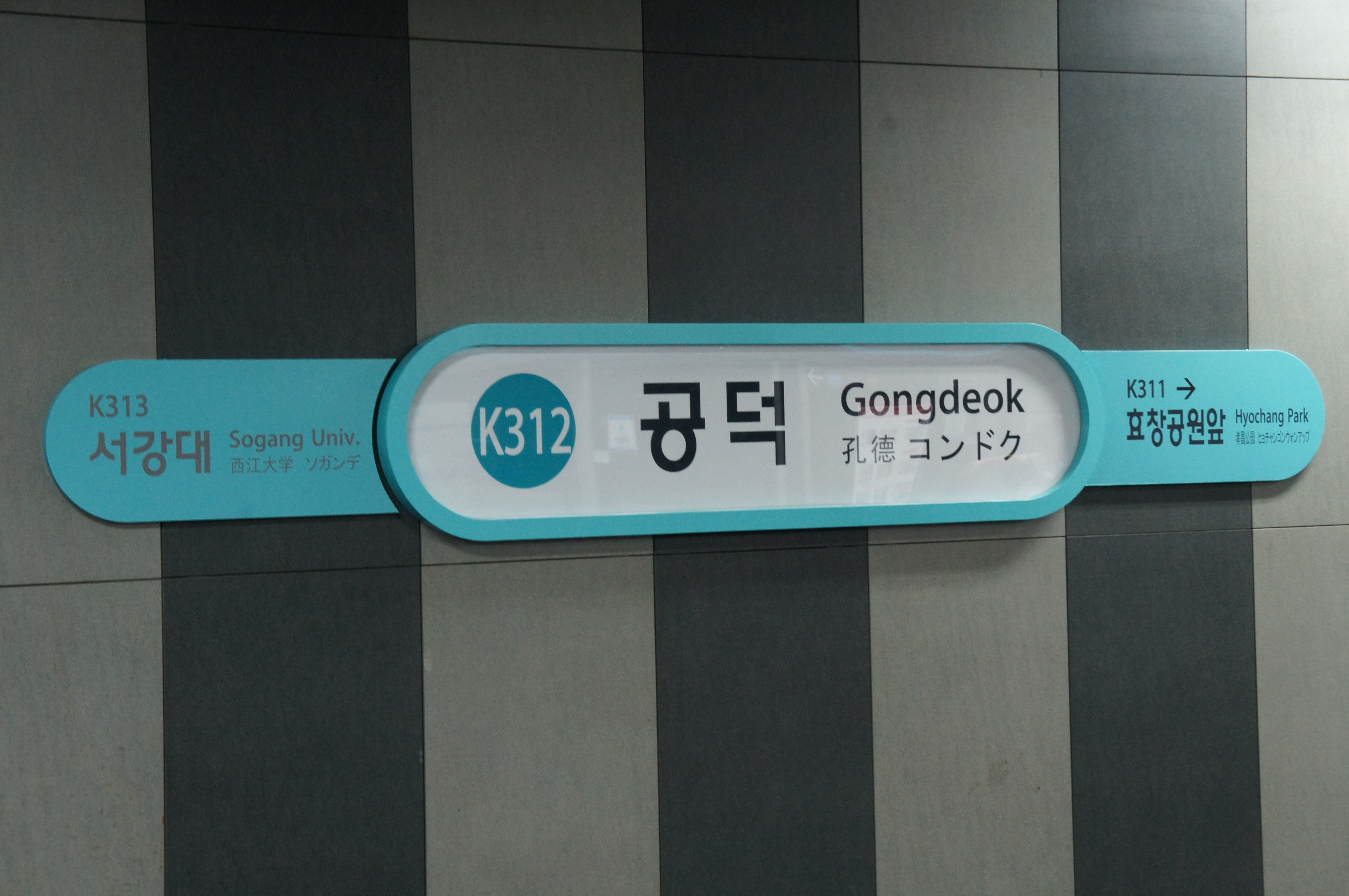|
Sugamo Station
is a railway station in Toshima, Tokyo, Japan, operated by the East Japan Railway Company (JR East) and Toei Subway. Lines Sugamo Station is served by the following two lines. * Yamanote Line * Toei Mita Line Station layout Platform edge doors were installed on the Yamanote Line platforms during fiscal 2013. JR East platforms File:JR Yamanote-Line Sugamo Station Gates.jpg, JR East ticket gates File:JR Yamanote-Line Sugamo Station Platform (20191130).jpg, Yamanote Line platforms Toei platforms File:Sugamo-Sta-Toei-Gate.JPG, Toei ticket gates File:Toei-subway-I15-Sugamo-station-platform-20191220-124135.jpg, Mita Line platform History The station opened on 1 April 1903. Station numbering was introduced in 2016 with Sugamo being assigned station number JY11. Passenger statistics In fiscal 2013, the JR East station was used by an average of 77,089 passengers daily (boarding passengers only), making it the 57th-busiest station operated by JR East. In fiscal 2013, the ... [...More Info...] [...Related Items...] OR: [Wikipedia] [Google] [Baidu] |
Sugamo
is a neighborhood in Toshima, Tokyo, Japan. It is home to , a shopping street popular among the older generation, earning it the nickname "Granny's Harajuku." It lies at the crossing point of the JR Yamanote Line and National Route 17. Available public transportation to Sugamo are JR Yamanote Line and Toei Mita Line. There is also Koshinzuka station of Toden Arakawa Line in the middle of shopping street. Tokugawa Yoshinobu, who is the last shogun of the Tokugawa Shogunate set his residence here in 1897. He has lived for 4 years there and moved away to avoid the noise coming from Yamanote Line The Yamanote Line ( ja, 山手線, Yamanote-sen) is a loop service in Tokyo, Japan, operated by the East Japan Railway Company (JR East). It is one of Tokyo's busiest and most important lines, connecting most of Tokyo's major stations and urban c .... Education Public elementary and junior high schools are operated by the Toshima Ward Board of Education. Sugamo is served by the ... [...More Info...] [...Related Items...] OR: [Wikipedia] [Google] [Baidu] |
Platform Edge Doors
Platform screen doors (PSDs), also known as platform edge doors (PEDs), are used at some train, rapid transit and people mover stations to separate the platform from train tracks, as well as on some bus rapid transit, tram and light rail systems. Primarily used for passenger safety, they are a relatively new addition to many metro systems around the world, some having been retrofitted to established systems. They are widely used in newer Asian and European metro systems, and Latin American bus rapid transit systems. History The idea for platform edge doors dates as early as 1908, when Charles S. Shute of Boston was granted a patent for "Safety fence and gate for railway-platforms". The invention consisted of "a fence for railway platform edges", composed of a series of pickets bolted to the platform edge, and vertically movable pickets that could retract into a platform edge when there was a train in the station. In 1917, Carl Albert West was granted a patent for "Gate for s ... [...More Info...] [...Related Items...] OR: [Wikipedia] [Google] [Baidu] |
Stations Of East Japan Railway Company
Station may refer to: Agriculture * Station (Australian agriculture), a large Australian landholding used for livestock production * Station (New Zealand agriculture), a large New Zealand farm used for grazing by sheep and cattle ** Cattle station, a cattle-rearing station in Australia or New Zealand **Sheep station, a sheep-rearing station in Australia or New Zealand Communications * Radio communication station, a radio frequency communication station of any kind, including audio, TV, and non-broadcast uses ** Radio broadcasting station, an audio station intended for reception by the general public ** Amateur radio station, a station operating on frequencies allocated for ham or other non-commercial use ** Broadcast relay station ** Ground station (or Earth station), a terrestrial radio station for extraplanetary telecommunication with satellites or spacecraft ** Television station * Courier station, a relay station in a courier system ** Station of the ''cursus publicus'', a sta ... [...More Info...] [...Related Items...] OR: [Wikipedia] [Google] [Baidu] |
Railway Stations In Japan Opened In 1903
Rail transport (also known as train transport) is a means of transport that transfers passengers and goods on wheeled vehicles running on rails, which are incorporated in tracks. In contrast to road transport, where the vehicles run on a prepared flat surface, rail vehicles (rolling stock) are directionally guided by the tracks on which they run. Tracks usually consist of steel rails, installed on sleepers (ties) set in ballast, on which the rolling stock, usually fitted with metal wheels, moves. Other variations are also possible, such as "slab track", in which the rails are fastened to a concrete foundation resting on a prepared subsurface. Rolling stock in a rail transport system generally encounters lower frictional resistance than rubber-tyred road vehicles, so passenger and freight cars (carriages and wagons) can be coupled into longer trains. The operation is carried out by a railway company, providing transport between train stations or freight customer faciliti ... [...More Info...] [...Related Items...] OR: [Wikipedia] [Google] [Baidu] |
List Of Railway Stations In Japan ...
The links below contain all of the 8579 railway stations in Japan. External links {{Portal bar, Japan, Trains * Railway stations Japan Japan ( ja, 日本, or , and formally , ''Nihonkoku'') is an island country in East Asia. It is situated in the northwest Pacific Ocean, and is bordered on the west by the Sea of Japan, while extending from the Sea of Okhotsk in the north ... [...More Info...] [...Related Items...] OR: [Wikipedia] [Google] [Baidu] |
Harajuku
is a district in Shibuya, Tokyo, Japan. Harajuku is the common name given to a geographic area spreading from Harajuku Station to Omotesando, corresponding on official maps of Shibuya ward as Jingūmae 1 chōme to 4 chōme. In popular reference, Harajuku also encompasses many smaller backstreets such as Takeshita Street and Cat Street spreading from Sendagaya in the north to Shibuya in the south. Harajuku is known internationally as a center of Japanese youth culture and fashion. Shopping and dining options include many small, youth-oriented, independent boutiques and cafés, but the neighborhood also attracts many larger international chain stores with high-end luxury merchandisers extensively represented along Omotesando. Harajuku Station on the East Japan Railway (JR East) Yamanote Line and Meiji-jingumae 'Harajuku' Station served by the Tokyo Metro Chiyoda Line and Tokyo Metro Fukutoshin Line also act as gateways to local attractions such as the Meiji Shrine, Yoyogi ... [...More Info...] [...Related Items...] OR: [Wikipedia] [Google] [Baidu] |
Shōtengai
A shōtengai () is a style of Japanese commercial district, typically in the form of a local market street that is closed to car traffic. Local shōtengai cater to the needs of nearby residents with a diverse mix of small specialty shops and few large retailers. In many older neighborhoods, these streets serve as cultural gathering spaces, holding seasonal festivals, processions, and other events throughout the year. Many older shōtengai developed along roads leading to large shrines or temples; Nakamise-dōri to Sensō-ji, Asakusa is a typical example. More modern shōtengai often connect to the nearest train or subway station, or other public gathering points such as large parks or landmarks. Most suburbs and towns of Japan have shōtengai of varying size, and larger shōtengai may take the form of covered arcades that are accessible only by foot or bicycle. Commercial features A neighborhood shōtengai may be anchored by one or two large retailers (such as a grocery store ... [...More Info...] [...Related Items...] OR: [Wikipedia] [Google] [Baidu] |
Station Numbering
Station numbering is a sign system which assigns station codes consisting of a few letters and numbers to train stations. It aims to facilitate navigation for foreign travelers not familiar with the local language by using globally understood characters (Latin letters and Arabic numbers). The system is now in use by various railway companies around the world such as in Mainland China, Indonesia, Japan, South Korea, Singapore, Taiwan, Thailand, and the United States. History Station numbering first introduced—but to less fanfare—in South Korea, by the Seoul Metropolitan Subway in 1983 as a section of Seoul Subway Line 2 ( Euljiro 1-ga to Seongsu) was opened. Its first usage in Japan was in the Nagasaki Electric Tramway where it was introduced in May 1984."History of Nagasaki Electric Tramway line transition", ''Stadtbahn'' issue 9, April 1984 The Tokyo subway system introduced station numbering in 2004. Sports events are usually the turning point for the introduction of s ... [...More Info...] [...Related Items...] OR: [Wikipedia] [Google] [Baidu] |
Toei Mita Line
The is a subway line of the Tokyo Metropolitan Bureau of Transportation (Toei) network in Tokyo, Japan. The line runs between Nishi-Takashimadaira in Itabashi and Meguro in Shinagawa. Trains continue with direct service into the Meguro Line of Tokyu Corporation for . The portion between and Meguro is shared with the Tokyo Metro Namboku Line. The line was named after the Mita district in Minato, Tokyo, under which it passes. On maps and signboards, the line is shown in blue (). Stations carry the letter "I" followed by a two-digit number. Overview Platforms on the Mita Line are equipped with chest-height automatic platform gates that open in sync with the train doors. The line was the first in the Tokyo subway system to have low barriers. The Tokyo Metro Namboku Line has used full-height platform screen doors since its opening. As of May 2020, the platform doors are being overhauled for future 8 car operations. The right-of-way and stations between Shirokane-Takanawa and M ... [...More Info...] [...Related Items...] OR: [Wikipedia] [Google] [Baidu] |
Toshima
is a special ward in Tokyo, Japan. It is one of the eight central wards of the Tokyo Metropolitan area. Located in the northern area of Tokyo, Toshima is bordered by the wards of Nerima, Itabashi, and Kita in the north and Nakano, Shinjuku, and Bunkyo in the south. The ward was founded on March 15, 1947, and reached a peak resident population of 370,000 in 1965. The population has continued to decline and as of May 1, 2015, the ward had an estimated population of 298,250, with a population density of 22,920 persons per km2. During the day the population swells with commuters, resulting in a daytime population of around 378,475. The total land area of Toshima is 13.01 km2, sitting on a moderate plateau with a difference of 28 m between the ward's highest and lowest points. Approximately 47% of Toshima's land is residential, and 20% is commercial and public areas. Although Toshima is a ward, it is referred to as a city. The ward offices are located in Ikebukuro, which is als ... [...More Info...] [...Related Items...] OR: [Wikipedia] [Google] [Baidu] |
Toei Subway
The is one of two subway systems in Tokyo, the other being Tokyo Metro. The Toei Subway lines were originally licensed to the Teito Rapid Transit Authority (the predecessor of Tokyo Metro) but were constructed by the Tokyo Metropolitan Government following transfers of the licenses for each line. The subway has run at a financial loss for most of its history due to high construction expenses, particularly for the Oedo Line. However, it reported its first net profit of ¥3.13bn in FY2006. The Toei Subway is operated by the Tokyo Metropolitan Bureau of Transportation. Tokyo Metro and Toei trains form completely separate networks. While users of prepaid rail passes can freely interchange between the two networks, regular ticket holders must purchase a second ticket, or a special transfer ticket, to change from a Toei line to a Tokyo Metro line and vice versa. The sole exceptions are on the segment of the Toei Mita Line between Meguro and Shirokane-Takanawa, where the platforms are sh ... [...More Info...] [...Related Items...] OR: [Wikipedia] [Google] [Baidu] |
East Japan Railway Company
The is a major passenger railway company in Japan and is the largest of the seven Japan Railways Group companies. The company name is officially abbreviated as JR-EAST or JR East in English, and as in Japanese. The company's headquarters are in Yoyogi, Shibuya, Tokyo, and next to the Shinjuku Station. It is listed in the Tokyo Stock Exchange (it formerly had secondary listings in the Nagoya Stock Exchange, Nagoya and Osaka Exchange, Osaka stock exchanges), is a constituent of the TOPIX Large70 index, and is also one of the three only Japan Railways Group constituents of the Nikkei 225 index, the other being Central Japan Railway Company, JR Central and West Japan Railway Company, JR West. History JR East was incorporated on 1 April 1987 after being spun off from the government-run Japanese National Railways (JNR). The spin-off was nominally "privatization", as the company was actually a wholly owned subsidiary of the government-owned Japanese National Railway Settlement ... [...More Info...] [...Related Items...] OR: [Wikipedia] [Google] [Baidu] |






